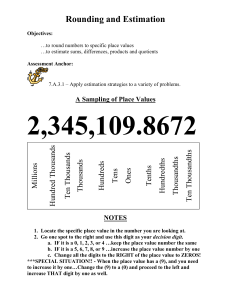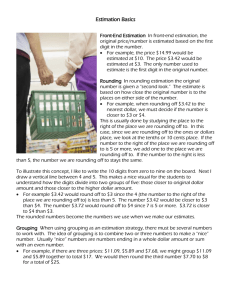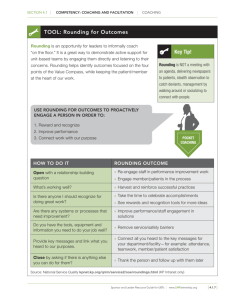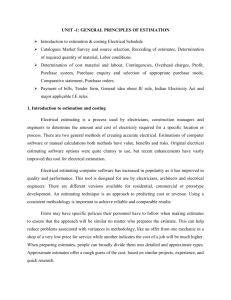Field Advisor Observation Math Pathwise
advertisement
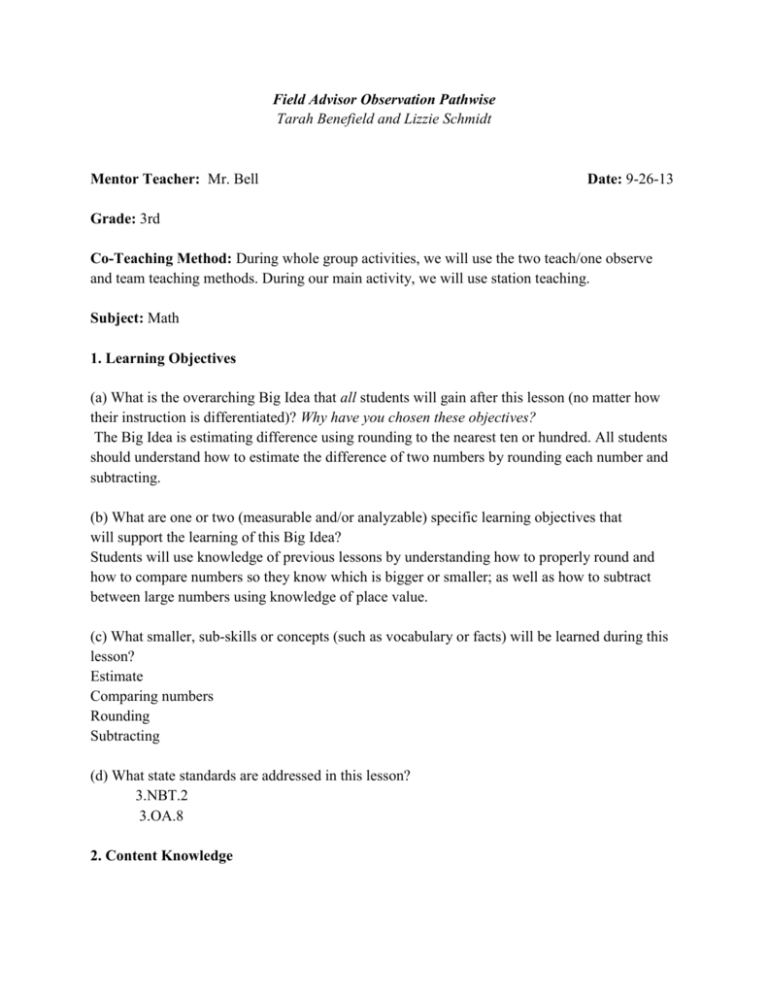
Field Advisor Observation Pathwise Tarah Benefield and Lizzie Schmidt Mentor Teacher: Mr. Bell Date: 9-26-13 Grade: 3rd Co-Teaching Method: During whole group activities, we will use the two teach/one observe and team teaching methods. During our main activity, we will use station teaching. Subject: Math 1. Learning Objectives (a) What is the overarching Big Idea that all students will gain after this lesson (no matter how their instruction is differentiated)? Why have you chosen these objectives? The Big Idea is estimating difference using rounding to the nearest ten or hundred. All students should understand how to estimate the difference of two numbers by rounding each number and subtracting. (b) What are one or two (measurable and/or analyzable) specific learning objectives that will support the learning of this Big Idea? Students will use knowledge of previous lessons by understanding how to properly round and how to compare numbers so they know which is bigger or smaller; as well as how to subtract between large numbers using knowledge of place value. (c) What smaller, sub-skills or concepts (such as vocabulary or facts) will be learned during this lesson? Estimate Comparing numbers Rounding Subtracting (d) What state standards are addressed in this lesson? 3.NBT.2 3.OA.8 2. Content Knowledge a) What is the underlying content knowledge that the teacher must help the students understand? Rounding - the teacher must help the students understand when to round and how to round to certain place values. Estimation - the teacher must help the students understand what it means to estimate, and how students can use estimation every day. Comparing - teacher must help students understand that some numbers are bigger than others and how to compare numbers being less than, greater than, or equal to each other. Place Value - teacher must help students understand the importance of place value and determining the values of each place. Sequencing and Order - teacher must help students understand numbers come in a certain order, and numbers closer together on the number line will have smaller differences than numbers farther apart on the number line. b) When you deconstruct the content you are teaching, what are the pieces that are essential for children to understand? Place value, comparing numbers (>, <, =), rounding, sequencing and order, and the meaning of estimation. c) What are the tricky pieces in the content (what might be confusing, concerning, developmentally challenging)? We believe it will be most challenging for students to understand how to estimate the difference in numbers. It will be challenging for them to round or estimate then subtract. 3. Activities: What are the specific teaching behaviors that will occur during the lesson in order to facilitate the learning of the specific learning objective (b) listed above? Remember, if you have different groups doing different activities, each group’s activity must be clearly explained. This is often the longest section of your lesson plan. Activities Time Allowed Opening: Calendar Math and Introduction 15 Minutes To begin our math lesson, we will use calendar math strategies and discuss what the students are learning. This introduction is familiar to the students and a review of what they need to know for today’s lesson. We will begin by identifying the amount of “money” we have from this school year so far. Each day, we add the number of days of school we have had so far to our total, so on this day we will add $xyz and $28, because it is the 28th day of school. We will ask students to help us in this process, and identify place value of our new amount of money. We will also ask students to identify the value of each dollar in our total. Next, we will ask students how many dollar bills we need to add to our bank. We will also review different ways to make up our new total, using place value and different amounts of money. We will use this total of money to compare other numbers and practice sequencing and ordering. We will also review >, <, and = in comparing. In addition, we will practice rounding the numbers we come up with. Ultimately, we want to let the students play with the numbers and use the skills they are learning, in a wholegroup setting. We will also review the pattern on the calendar and count by 2’s, 3’s, and 4’s. After we feel the students have had the opportunity to play with numbers and review rounding, patterns, and place value, we will write the word “estimate” on the board. We will ask students for a definition of the word. We will then show them a bag of candy corn and ask them to estimate how much is in the bag in their head, not tell their neighbor, and write their guess on a sticky note we give them; after we will collect their sticky notes. Then, we will then ask students for examples of times they have used estimation in their lives. After some discussion, we will explain to students that they will be working in small groups with Mr. Bell, Ms. Benefield and Ms. Schmidt on today’s lesson about estimating the difference between numbers. Main activity/activities: Small Groups and Independent Work 30 minutes Students will work in leveled groups with a co-teacher on pages 139 and 140. We will complete these pages as a group and the co-teacher will use the small white board to display the work so the students are provided with a visual larger than that in the book. Next, students will work independently on the questions assigned to their group from pages 141 and 142. (Approaching Level: 3,5, 7-8, 11-12, 14-16; On Level: 4-5, 9-10, 12-16; Beyond Level: 4, 6,10, 12-16). Students will be instructed to ask a partner first if they have a question and then ask their coteacher. Being in groups will allow the co-teachers to see which students are having trouble with this topic. If students finish early they will work on pages 147-148. Once students finish their work on pages 141 and 142 they will turn it in for our assessment. Closing: Wrap up 10 Minutes For the closing students will return to the floor with their original candy estimation sticky note. We will tell them to round their original estimation to the nearest hundred and then show them a smaller bag of candy and have them estimate this one as well. They will then round that number to the nearest hundred and then follow the steps to estimate the difference. The student who estimated closest with the first estimation will get to take the bag home. Important questions to ask students: -When estimating the difference do we subtract first or round first? -What does it mean to estimate and how does estimating help us in everyday life? 4. Materials a) What materials and resources will you use to implement this lesson (remember that this can include people, as well!)? -Math text -Smart Board -Candy -3 co-teachers -small white boards b) Why have you chosen these materials? We chose these materials because the text, SmartBoard and whiteboards are all visual materials to help students see what they are learning. The text holds the questions students will be working on to develop this skill. And the candy provides students with a real life example of estimating as well as extrinsic motivation. 5. Individual Accommodations: List all student names for learners who need special support to be successful students during instruction (at least 3!). Then list the specific accommodations you are planning to use each of these unique learners, whether they need special accommodations for a learning disability, for language development, for attention problems, for behavioral support, for giftedness, or simply from your own analysis. Remember, accommodations are not the same as differentiating instruction, although the two can overlap. Visiting the IEP, EP, or 504 plans for each student (if there is one) is a good place to start. Please do not list disabilities here as this is confidential information. Student Accommodation Mataya Mataya will work with the co-teacher on the independent questions by reading the questions together. However, they will not do the work or answer the questions together. Jesse The co-teacher will ensure he’s engaged by scaffolding and asking questions specifically to him so he remains active and involved and completes his work. Ian Ian will complete the Beyond Level questions on page 141-142 and then move ahead to complete pages 147-148. He will not be expected to stay with the group. 6. Levels of Differentiation Name, and then explain how you organized this lesson to address the 1st Level of Differentiation (learning style, readiness, and/or learning profile). Provide a strong rationale for your choices: We decided to split students into three leveled groups: Approaching Level, On Level and Beyond Level for the main activities of our lesson. The text provides different questions for each level, and we believed that splitting the students in groups by profile will increase the chance for their needs to be met. The criteria in the learning profiles of the students we looked at were observations of previous experiences working with each student strictly in math, chapter one tests scores from math, and progress report grades in math. Name and then explain what portions of your lesson address the 2nd Level of Differentiation (content, process, and/or product). Provide a strong rationale for your choices: Because we put the students in groups based on similar learning profiles, and had students work on math questions from the text, our main activities in the lesson focused on the product for the 2nd level of differentiation. The students were all taught the same process for estimating differences from the text by either Mr. Bell, Ms. Schmidt or Ms. Benefield. However, each of the groups may come up with different products based on the components in their learning profiles. 7. Grouping*: How did you build groups for instruction? Why? Your reasoning must show strong evidence of your understanding of differentiating instruction and of your unique group of learners. We built groups based on learning profiles. We grouped students according to who was most similar in the components of our learning profiles: observations, chapter one test scores, and progress report grades in math. *Please note: If you choose to group students by ability (or “readiness”), you will need to prepare a convincing rationale for this decision. You are highly encouraged to group students in a different way for this one lesson! 8. Data Collection Plan: What combination of evaluation/assessment data do you plan to collect before, during, and after the lesson in order to provide evidence of student learning of (1) your Big Idea and your (2) learning objectives? (Examples: responses to test/quiz questions and/or scores, student work products or performances, teacher’s journal, observations and field notes, photographs/video, surveys…) Before the Lesson: We will reflect on our experiences of working with the students, look at chapter one test scores, and progress report grades in math to put the students in groups based on learning. We will reflect on how the students have been doing during previous lessons about base ten, rounding, comparing, sequencing and ordering numbers. We will also use field notes to look back on specific students’ performance in previous lessons pertaining to these skills. During the Lesson: We will observe how closely the students estimate numbers and how much they grasp the concept. We will also look at their work on page 141 and 142 and the questions they are assigned. After the Lesson: We will collaborate on student performance within our groups and look at examples of student work on the questions they were assigned. Adapted for University of Florida Pathwise Instruction and Reflection Form by Vicki Wilson for Salt Fork (Region 10) RPDC and Muskingum Valley Educational Service Center/Muskingum College Goals 2000.
